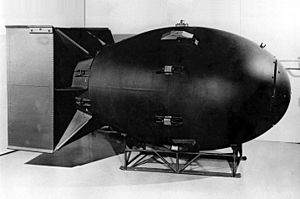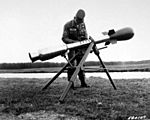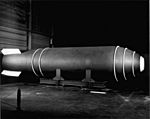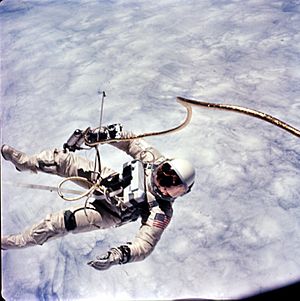Nuclear weapons delivery facts for kids
Nuclear weapons delivery is about the ways nuclear weapons are moved and dropped onto their targets. Over time, many different methods have been created to do this.
There are two main types of nuclear weapons:
- Strategic weapons are very powerful. They are used to threaten big targets like cities. This is part of a plan called deterrence, which means stopping an enemy from attacking by showing you can hit them back hard.
- Tactical weapons are smaller. They are used in battles to destroy specific military targets, communication centers, or important buildings.
Today, strategic weapons are usually much more powerful than tactical ones. But this isn't always true. The bombs dropped on Hiroshima and Nagasaki in 1945 were less powerful than many tactical weapons used today. However, they were used strategically and had a huge impact.
Contents
The Nuclear Triad
A nuclear triad means a country has three different ways to deliver nuclear weapons. These are:
- Bombers (planes that drop bombs)
- Intercontinental ballistic missiles (ICBMs) launched from land
- Submarine-launched ballistic missiles (SLBMs) launched from submarines
Having these three ways makes it very hard for an enemy to destroy all of a nation's nuclear weapons in a surprise attack. This means the country can always hit back, which makes its nuclear deterrence stronger.
Main Ways to Deliver Nuclear Weapons
Gravity Bombs
The first way nuclear weapons were delivered was by dropping them from planes. This is how the only two nuclear bombs ever used in war were delivered. For many years, nuclear bombs dropped from planes were the main way to deliver these weapons. Even today, many nuclear weapons in the US are bombs carried by planes.
Gravity bombs are made to be dropped from planes. This means they must be strong enough to handle shaking and changes in air temperature and pressure during a flight. Early bombs were so big and heavy that only very large bombers could carry them. These included planes like the B-36 Peacemaker and the B-52 Stratofortress. By the mid-1950s, smaller bombs were made that could be carried by fighter-bombers too.
Pilots use different ways to drop these bombs. Some methods, like "toss bombing" or using parachutes, give the plane time to fly away before the bomb explodes.
Ballistic Missiles

Missiles that use a ballistic path usually deliver a warhead (the explosive part) over very long distances, sometimes thousands of kilometers. These include intercontinental ballistic missiles (ICBMs) and submarine-launched ballistic missiles (SLBMs). Most ballistic missiles fly out of Earth's atmosphere and then come back down towards their target.
ICBMs are much faster than planes. They fly at very high altitudes, making them hard to stop. They can also be launched quickly if there's a surprise attack.
Early ballistic missiles carried only one warhead, which was often very powerful. This was because the missiles weren't very accurate. So, a huge explosion was needed to make sure the target was destroyed. Since the 1970s, missiles have become much more accurate. This allowed for smaller warheads. It also led to the development of multiple independently targetable reentry vehicles (MIRV). This means one missile can carry several warheads, and each warhead can hit a different target.
For example, one D5 Trident missile carried by a submarine can launch eight separate warheads. This makes it much harder for anti-missile defenses to stop them.
Cruise Missiles
A cruise missile is a missile powered by a jet engine or rocket. It flies at a low height and uses a computer system to guide itself. They are designed to fly low to avoid being seen or stopped. Cruise missiles can carry nuclear warheads. They don't fly as far as ballistic missiles and carry smaller warheads.
The AGM-86 ALCM is a nuclear-armed cruise missile used by the US Air Force. It is carried by the B-52 Stratofortress bomber, which can carry 20 of these missiles. Cruise missiles can also be launched from mobile launchers on the ground or from naval ships.
Even though they carry smaller warheads, cruise missiles have some advantages over ballistic missiles:
- It's hard for satellites to detect a cruise missile launch early. This helps create a surprise attack.
- They can change direction during flight. This helps them get past missile defense systems that are designed to stop ballistic missiles.
Other Delivery Systems
Besides bombs and missiles, nuclear weapons have been designed for other uses. These include:
- Artillery shells: These are fired from large guns.
- Mines: These are placed on the ground, like the Medium Atomic Demolition Munition.
- Nuclear depth charges: Used underwater against submarines.
- Nuclear torpedoes: Launched from submarines to hit ships.
There was even an "Atomic Bazooka" designed to be used against large groups of tanks.
In the 1950s, the US also made small nuclear warheads for air defense, like the Nike Hercules missile. These were meant to shoot down enemy planes.
A new possible way to deliver nuclear weapons is with Hypersonic Glide Vehicles. These vehicles can fly at incredibly high speeds and are very hard to stop.
Costs and Unexpected Benefits
Between 1940 and 1996, the US spent a huge amount of money on nuclear weapons programs. More than half of this money was spent on building the ways to deliver these weapons, like missiles and bombers.
Technology Spin-offs
Even though a lot of money was spent on weapons, some of this research led to amazing technologies we use every day!
Launch Vehicles
Some missiles built for nuclear weapons, like the Atlas ICBM and Titan II, were later used to launch humans into space. The Atlas rocket sent John Glenn, the first American, into orbit. In the Soviet Union, the R-7 ICBM was used to launch the first artificial satellite, Sputnik, and the first human in space, Yuri Gagarin. A modern version of the R-7 is still used today to launch the Soyuz spacecraft.
Weather Satellites
The first real weather satellite, TIROS-1, was launched in 1960 using a rocket that came from a missile program. The Soviet Union's first weather satellite, Meteor 1, was also launched on a rocket based on the R-7 ICBM.
Lubricants
WD-40 was first used to protect the thin metal fuel tanks of the Atlas missile from rust. These tanks were so thin they had to be kept inflated with gas when empty!
Heat-Resistant Materials
In 1953, a scientist named Dr. S. Donald Stookey invented Pyroceram, a special glass material that can handle very sudden temperature changes. This material was first developed for nose cones of ballistic missiles, which get extremely hot when re-entering the atmosphere. This technology later led to things like CorningWare kitchen products.
Satellite Positioning
The need for submarines to know their exact location before launching missiles led to the development of satellite navigation systems. This research eventually resulted in the GPS we use today.
Global Positioning System
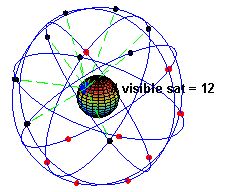
In 1973, military officers met to create a "Defense Navigation Satellite System." This became Navstar, which we now call GPS.
The first satellite navigation system, Transit, was tested in 1960 by the United States Navy. It helped submarines know their location. Later, in the 1970s, the Timation satellite proved that accurate clocks could be placed in space, which was key for GPS.
Developing GPS cost billions of dollars. During the Cold War, the threat of nuclear war was the main reason the US government decided to fund it. Being able to know the exact launch position of missiles made the nuclear deterrence much stronger.
The Navy and Air Force both needed better navigation. The Air Force wanted to use mobile launch platforms for their ICBMs, which also needed precise location data. All these needs pushed the development of GPS forward.
Another system called SECOR (Sequential Collation of Range) was used by the United States Army in 1964 for surveying. GPS can be seen as an advanced version of SECOR, where the transmitters are in space instead of on the ground.
See also


